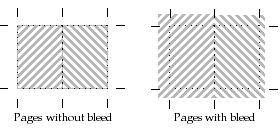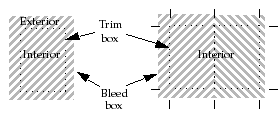Bleeds are commonly used in some kinds of imposition. They allow pages to spill over the edge of their normal area. The reason for using bleeds is usually so that printed pages can have a printed image right to the edge of the paper, despite inaccuracies in trimming.

Quite Imposing allows you to define bleeds which work in all imposition contexts: n-up, step and repeat, manual, and booklet. Bleeds can be created using Tile pages , but they are also a standard and may be generated by other tools. QuarkXPress and Adobe InDesign may store bleed information, and if it is stored, Quite Imposing will use it.
When a page has a bleed area defined there will always be a bleed exterior and a bleed interior. The exterior is the area that will appear on the final sheet. The interior is the area that will be lined up with the imposition.

The interior and exterior are enclosed by (usually invisible) boxes called the trim box and the bleed box. If the trim box and bleed box are the same, there is no bleed exterior at all, and the page is said to have no bleed defined.
Calculations for imposition use the bleed interior (trim box) to work out the layout. It is the bleed interior that lines up with crop marks. The bleed exterior runs outside this area and may overlap the crop marks.
The illustration above also shows a feature of Quite Imposing when it is laying out a page: it tries to avoid overlapping bleeds where pages are close or touch. This is automatic, except in Manual Imposition , and means that bleeds do not have to be removed where they might otherwise overlap.
The five page boxes
Each page in a PDF has five invisible boxes. They are optional, but there are strict rules about what to use if a particular box is missing.
- The
media box is best thought of as the original page size. It is always defined.
It must enclose, or be the same as, all the other boxes. This does not often
change, though Quite Imposing will increase it if needed for Trim And Shift .
- The
crop box is the size to which a page has been cropped, typically with the crop
box in Acrobat, though some new created documents are already cropped. The crop
box is very important in Acrobat as it is the page that you see on screen.
Anything outside the crop box is invisible (though changing the crop box may
make it visible). Trim And Shift often adjusts the crop box.
If there is no crop box, the media box must be used.
- The
trim box is the interior of the bleed, which aligns with the imposition. So this is the most important size from the point of view of
imposing, whatever is visible on screen. If there is no trim box, it is the
same as the crop box (if present) or media box otherwise.
- The
bleed box is the exterior of the bleed. If absent, the trim box is used.
- The
art box is not used in imposition and is not used or set by Quite Imposing.
The
problem with automatic bleeds
As noted above, applications like QuarkXPress or InDesign may automatically set bleed information. This is often a great time saver when making impositions.
Unfortunately, cropping pages can lead to surprising results. This because of the rules we have described above in The five page boxes . Cropping pages sets the crop box but does not alter the trim box or bleed box.
The result of this is that typically a cropped page imposes exactly as if it was never cropped at all.
Quite Imposing tries to help in two ways:
1. When you use Trim And Shift ,
Quite Imposing will remove the bleed and trim information. When Preserve PDF/X
is selected in Imposition Preferences the
trim box is instead set the same as the crop box.
2. In Quite Imposing 2.0, a
warning message is issued on each imposition where a page contains bleeds. This
gives the choice of either using the bleeds (imposing as described above) or
ignoring them (imposing using the visible part of the page, with no bleeds).
The aim of this is to make the imposition process more predictable, and remove unpleasant surprises. Of course, the prompt may be a nuisance if the situation was well understood, so you can turn off the prompt in Imposition Preferences or for each imposition. When the prompt is turned off, you can have Quite Imposing either use or ignore the bleed in every case.
The warning message is not issued when the trim box and crop box are equal, and is not issued when running Automation sequences in Advanced Batch mode.